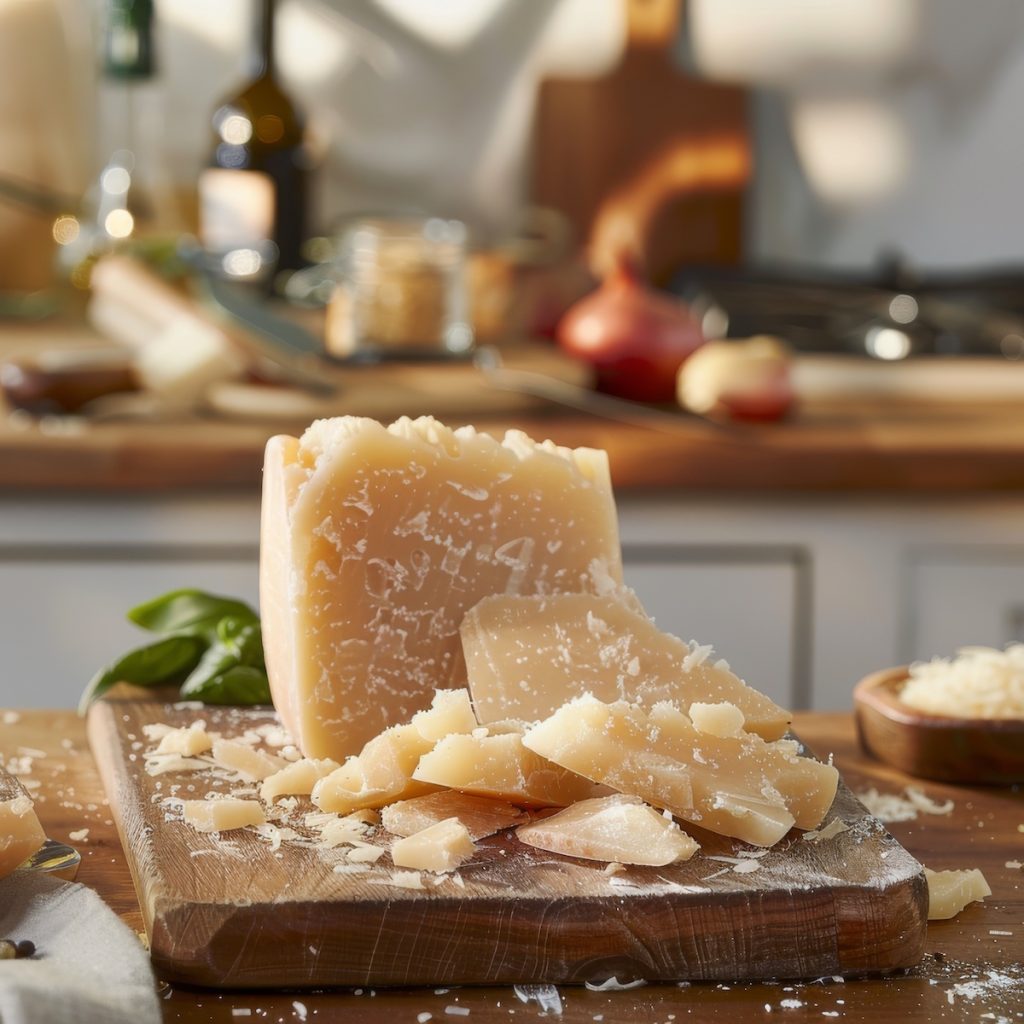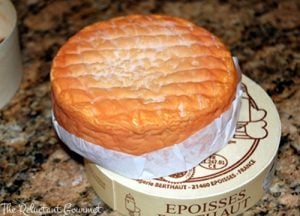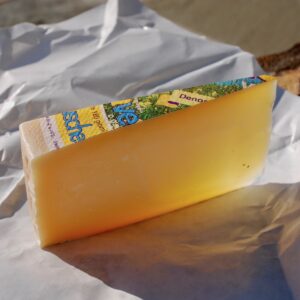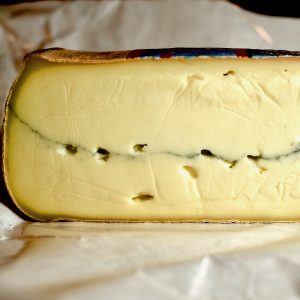The King of Cheese
Parmesan cheese is a hard, nutty cheese made from cow’s milk and is native to Italy. It is versatile and used in various dishes. It is known for its sharp, salty flavor and granular texture.
The origins of Parmesan cheese can be traced back to the 13th century when it was first made in Italy’s Parma and Reggio Emilia regions. Monks originally made the cheese to preserve milk, and it quickly gained popularity due to its rich, nutty flavor and granular texture.
Over the centuries, the production of Parmesan cheese has evolved and become more refined. In the 19th century, the Parmigiano-Reggiano cheese consortium was formed, which established strict guidelines for producing Parmesan cheese and helped ensure its quality and consistency. Today, Parmesan cheese is protected by a Protected Designation of Origin (PDO) status, which means that it can only be made in specific regions of Italy using specific methods.
Parmesan cheese has become a beloved and iconic cheese worldwide, and it is used in various dishes in many cuisines. It is a versatile cheese that can be grated over dishes, used as an ingredient in sauces, or eaten on its own as a snack. It is also a popular topping for pizza and is often used in Italian cuisine.
Despite its widespread popularity, Parmesan cheese remains deeply rooted in its Italian origins and is still made using traditional methods that have been passed down for generations. As a result, it is a true culinary masterpiece that is enjoyed by food lovers all over the world.
Parmesan cheese is made by heating and curdling cow’s milk and separating the curds from the whey. The curds are then placed in molds and pressed to remove excess moisture. The cheese is aged for at least one year, and it is turned and brushed regularly during this time to prevent mold development.

Parmesan cheese has a hard, pale yellow rind and a pale yellow interior with a granular texture. Its sharp, nutty flavor becomes more complex and piquant as it ages. The flavor is often described as slightly fruity, with hints of nuts and a slightly salty finish.
It has a hard, granular texture that is slightly crumbly. It can be grated finely or shaved into thin slices. Its strong, robust flavor pairs well with various dishes.
Parmesan cheese has a strong, sharp, and nutty flavor that becomes more complex and piquant as it ages. It is often described as slightly fruity, with hints of nuts and a slightly salty finish. The flavor of the cheese is influenced by the type of milk used, the aging process, and the methods used to make it.
Regarding smell, Parmesan cheese has a strong and distinctive aroma often described as nutty and slightly pungent. The aroma of the cheese is influenced by the type of milk used and the aging process, and it can vary depending on the specific type of Parmesan cheese.
Several different types, including Parmigiano-Reggiano, Grana Padano, and Parmesan cheese, are made in other countries. Parmigiano-Reggiano and Grana Padano are both made in Italy and have a Protected Designation of Origin (PDO) status, which means that they can only be made in specific regions of Italy using specific methods.
Parmesan cheese made outside of Italy may be labeled as “Parmesan,” but it may not have the same flavor or quality as Parmigiano-Reggiano or Grana Padano.
It is a good source of protein and contains several essential nutrients, including calcium, phosphorus, and vitamin B12. Some studies have also suggested that Parmesan cheese may have antimicrobial properties and may help reduce the risk of certain types of infections.
However, it is essential to remember that Parmesan cheese is high in sodium and fat and should be consumed in moderation as part of a well-balanced diet. Like all cheeses, Parmesan cheese is best consumed as part of a varied and healthy diet that includes various foods.
Regarding fat content, Parmesan cheese is relatively high in fat compared to other cheese types. According to the United States Department of Agriculture (USDA), a one-ounce (28 gram) serving of Parmesan cheese contains approximately 8 grams of fat, of which 5 grams is saturated fat. This is equivalent to approximately 10% of the recommended daily value for fat and 8% for saturated fat based on a 2,000-calorie diet.
Suppose you are concerned about your sodium or fat intake. In that case, you may consider using Parmesan cheese in smaller quantities or choosing a lower-fat or lower-sodium cheese as an alternative. It is also a good idea to speak with a healthcare professional or a registered dietitian if you have specific concerns about your diet and nutrition.
Parmesan cheese is versatile and can be used in various dishes, including pasta, risotto, soups, and salads. It is also a popular topping for pizza and can be shaved or grated over dishes for added flavor and texture. Parmesan cheese is often used in Italian cuisine, but it is also popular in many other cuisines worldwide.
One of the unique characteristics of Parmesan cheese is its ability to be grated finely and used as a garnish or topping for dishes.

- Caesar Salad: This classic salad is made with crisp romaine lettuce, croutons, and a dressing made from parmesan cheese, anchovies, garlic, lemon juice, and olive oil.
- Spaghetti Carbonara: This popular Italian dish is made with spaghetti, eggs, bacon or pancetta, and parmesan cheese. The pasta is tossed with the creamy egg and cheese mixture, creating a rich and satisfying meal.
- Baked Parmesan Tomatoes: This simple and delicious recipe involves slicing tomatoes and topping them with a mixture of parmesan cheese, breadcrumbs, and olive oil. The tomatoes are then baked until the cheese is melted and golden.
- Chicken Parmesan: This recipe involves coating chicken breasts with a mixture of parmesan cheese, breadcrumbs, and seasonings and then baking or pan-frying the chicken until it is crispy and golden brown.
- Parmesan Risotto: This creamy and flavorful dish is made with arborio rice, parmesan cheese, white wine, and chicken or vegetable broth.
Parmesan cheese, also known as Parmigiano-Reggiano, is typically made in Italy’s Parma and Reggio Emilia regions and has a Protected Designation of Origin (PDO) status, which means that it can only be made in these specific regions using specific methods.
However, other types of cheese similar to Parmesan cheese are made in other countries and may be labeled “Parmesan.” These cheeses may be made using similar methods and ingredients, but they may not have the same flavor or quality as Parmesan cheese made in Italy.
If you want to be sure that you are purchasing authentic Parmesan cheese, it is a good idea to look for cheese labeled as “Parmigiano-Reggiano” or “Grana Padano,” which are both PDO cheeses made in Italy. These cheeses have been produced using traditional methods and are subject to strict quality control standards, which helps to ensure their authenticity and flavor.

When shopping for parmesan cheese, here are a few things to consider:
- First, choose a high-quality brand: Look for brands that use traditional production methods and milk from grass-fed cows.
- Look for the “Parmigiano-Reggiano” label. Parmesan cheese labeled “Parmigiano-Reggiano” must be produced in a specific region of Italy using specific methods, so it is generally considered to be of higher quality.
- Consider the age of the cheese: Parmesan cheese can be aged for up to three years, and the longer it is aged, the more intense and flavorful it will be. However, older parmesan can also be more expensive.
- Decide between grated or block parmesan: Grated parmesan is convenient to use, but it can lose its flavor more quickly than a block of cheese. A block of parmesan will last longer, but it must be grated or shaved before use.
- Check the expiration date. Choose parmesan cheese with a long shelf life to keep it fresh for as long as possible.
Parmesan cheese is best stored in the refrigerator, which will keep for several months. Here are a few tips for storing parmesan cheese:
- Wrap the cheese tightly: Use plastic wrap or aluminum foil to wrap the cheese tightly, removing as much air as possible. This will help prevent the cheese from drying out and becoming crumbly.
- Store the cheese in the cheese drawer: Parmesan cheese is best stored in the cheese drawer of your refrigerator, which is typically the most humid area.
- Don’t store the cheese near strong-smelling foods: Parmesan cheese is quite porous, so it can absorb the flavors of other foods stored near it. Store it away from strongly scented foods to prevent the cheese from taking on unwanted flavors.
- Grate the cheese as needed: If you have a block of parmesan cheese, it is best to grate or shave the amount you need for a recipe rather than grating the entire block at once. Grated parmesan cheese will dry out more quickly than a block of cheese, so it is best to use it within a few days of grating.
- Freeze the cheese if you won’t be using it for a while: If you have a large block of parmesan cheese that you won’t be using for a while, you can freeze it to extend its shelf life. Just wrap the cheese tightly in plastic wrap or aluminum foil and place it in a resealable freezer bag before storing it in the freezer. Frozen parmesan cheese will keep for up to six months.
Parmigiano-Reggiano and Parmesan cheese are often used interchangeably, but they are not exactly the same. Parmigiano-Reggiano, also known as Parmesan cheese, is a hard, nutty cheese that is native to Italy and is made from cow’s milk.
It is typically aged for at least one year. It has a Protected Designation of Origin (PDO) status, meaning it can only be made in specific regions of Italy using specific methods. Parmigiano-Reggiano cheese is known for its sharp, nutty flavor and granular texture, and it is often considered to be the highest quality Parmesan cheese.
On the other hand, Parmesan cheese is a generic term that is often used to refer to any cheese similar to Parmigiano-Reggiano. It may be made from cow’s milk or a mixture of cow’s milk and other types of milk, such as skim milk or milk protein concentrate, and may contain additives and preservatives.
Parmesan cheese made outside of Italy may be labeled as “Parmesan,” but it may not have the same flavor or quality as Parmigiano-Reggiano cheese.
Parmigiano-Reggiano and Parmesan cheese are similar in terms of their flavor and texture. Still, Parmigiano-Reggiano is considered to be of higher quality and has a richer, more complex flavor than generic Parmesan cheese.
The cheese that is often sold in a green can or plastic container and labeled as “Parmesan cheese” or “grated Parmesan” may not be authentic. This cheese is often made from a mixture of cow’s milk and other types of milk, such as skim milk or milk protein concentrate, and may contain additives and preservatives.
It may also be made using methods different from authentic Parmesan cheese and may not be aged for as long. As a result, it may not have the same flavor or quality as authentic Parmesan cheese. In general, authentic Parmesan cheese is considered of higher quality and has a richer, more complex flavor than the cheese sold in a green can or plastic container.
Whether or not Parmigiano-Reggiano is worth the money is a subjective decision that will depend on your personal preferences and budget. Some people may feel that the high quality and unique flavor of Parmigiano-Reggiano make it worth the extra cost. In contrast, others may prefer to save money by choosing a cheaper alternative.
In general, Parmigiano-Reggiano is considered to be a premium cheese and is typically more expensive than other types of cheese. However, it is also a versatile cheese that can be used in various dishes and can add flavor and depth to your cooking. If you enjoy the flavor of Parmigiano-Reggiano and are willing to pay a little extra for it, it may be worth the investment.
Remember that Parmigiano-Reggiano is a hard cheese that can be grated or shaved into thin slices and used in various dishes, so a little bit goes a long way.

Parmesan cheese and Pecorino are both hard, aged cheeses native to Italy. They both have a sharp, nutty flavor and a granular texture, but they are made from different types of milk and have some distinct differences.
Parmigiano-Reggiano is made from cow’s milk and is aged for at least one year. It has a Protected Designation of Origin (PDO) status, meaning it can only be made in specific regions of Italy using specific methods. Parmesan cheese has a sharp, nutty flavor and a granular texture, and it is often used as a grating cheese or shaved over dishes for added flavor and texture.
On the other hand, Pecorino is made from sheep’s milk and is aged for a minimum of five months. It is a hard cheese made in several regions of Italy, including Tuscany, Lazio, and Sardinia. Pecorino has a sharp, salty flavor and a slightly softer texture than Parmesan cheese, and it is often used as a grating cheese or shaved over dishes for added flavor and texture.
Parmigiano-Reggiano and Pecorino are delicious and versatile cheeses enjoyed worldwide. They have similar flavors and textures, but they are made from different types of milk and have some distinct differences. Whether you prefer Parmigiano-Reggiano or Pecorino depends on your preferences and the specific recipe you are using.















